The Economics and Statistics Division maintains archives of previous publications for accountability purposes, but makes no updates to keep these documents current with the latest data revisions from Statistics Canada. As a result, information in older documents may not be accurate. Please exercise caution when referring to older documents. For the latest information and historical data, please contact the individual listed to the right.
<--- Return to Archive
For additional information relating to this article, please contact:
July 27, 2023POLICE REPORTED CRIME STATISTICS, 2022 Statistics Canada has released the 2022 results for police-reported crime statistics collected under the Uniform Crime Reporting (UCR) Survey. This annual publication measures the volume of crime, crime rates (per 100,000 population), and crime severity (based on sentencing data) by types of crime.
In 2022, Nova Scotia's crime rate (Criminal Code violations excluding traffic) was 5,973.3 incidents per 100,000 population. In comparison, Canada's crime rate for 2022 was 5,667.8 per 100,000 population. This was the second consecutive year that Nova Scotia's crime rate was higher than the national average. The lowest crime rates among provinces were in Quebec and Ontario while the highest were in Manitoba and Saskatchewan.
Halifax's crime rate was 5,660.5 incidents per 100,000 population.

Nova Scotia's crime rate (Criminal Code, excluding traffic) increased 8.2% in 2022, while there was a 14.8% increase in Halifax's crime rate.
Canada's crime rate increased by 5.0% in 2022. Crime rates increased in all provinces except British Columbia and New Brunswick. The largest increase in crime rate was reported in Manitoba.
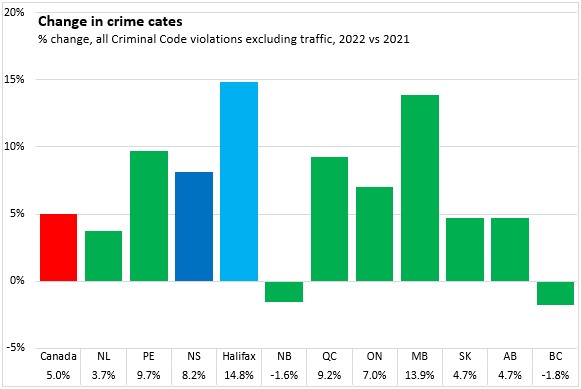
Crime rates declined steadily for many years before bottoming out around 2014 nationally and around 2016 in Nova Scotia. Since then, there has been a rising trend in crime rates (except 2020), though they have not returned to previous high levels.

Across Census Metropolitan Areas, crime rates were notably higher in Western Canada with the highest rate in Kelowna. Although crime rates were highest than the national average in Saskatoon, Regina and Winnipeg, areas outside the cities account more for high crime rates in Manitoba and Saskatchewan. Crime rates were generally lower across all cities in Ontario and Québec. In Atlantic Canada, Moncton reported a higher crime rate while Saint John's crime rate was lower than in other cities.
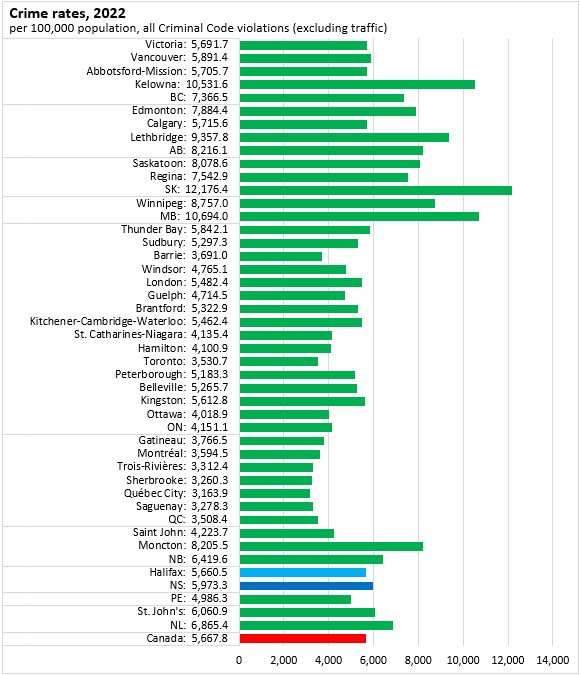
Compared to 2021, Winnipeg's crime rate increased the most among major urban centres. There were also notable increases in crime rates (faster than 10%) in Toronto, Peterborough, Ottawa, Gatineau, Montréal, Québec City, Halifax and St. John's. Moncton reported the largest decline in crime rates from 2021 to 2022.
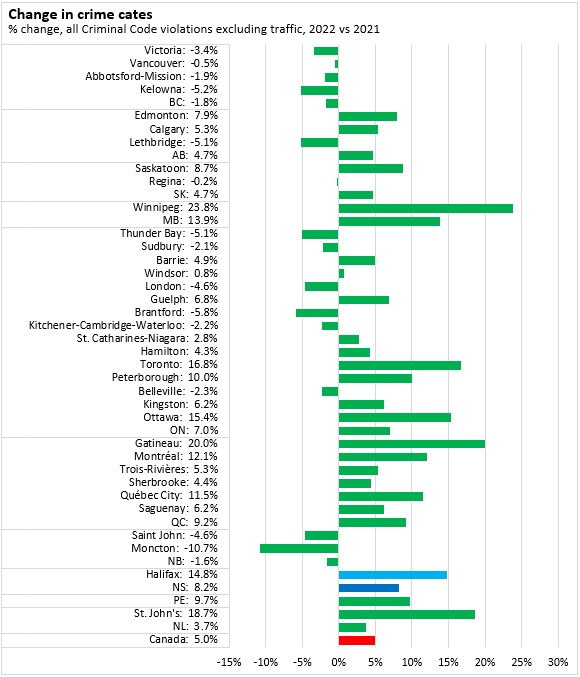
There were 1,590.5 reported violent Criminal Code violations per 100,000 residents in Nova Scotia during 2022. The national violent crime rate was 1,364.6 violations per 100,000 residents. Halifax reported a violent crime rate of 1,439.5 incidents per 100,000 residents.
There were 3,438.0 property violations per 100,000 residents in Nova Scotia and 944.8 other Criminal Code violations in 2022. Halifax reported 3,528.5 property crimes and 692.6 other Criminal Code violations per 100,000 residents in 2022. Nationally, there were 3,314.2 property violations and 989.0 other Criminal Code violations per 100,000 residents.
Manitoba and Saskatchewan reported the highest violent and property crime rates in 2022. Saskatchewan also had the highest rate of other Criminal Code violations. Québec reported the lowest rates of violent, property and other Criminal Code violations in 2022.
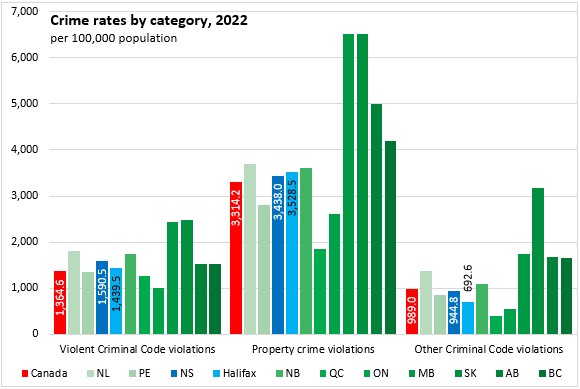
The rate of violent crimes was up 4.8% in Nova Scotia from 2021 to 2022 and up 13.5% in Halifax. Violent crime was up 2.5% nationally with increases in seven provinces. Prince Edward Island and Manitoba reported the fastest rises in violent crime while British Columbia and Newfoundland and Labrador reported the largest declines.
Property crime rates were up 10.5% in Nova Scotia from 2021 to 2022 with a 17.0% increase in Halifax. Nationally, property crime rates were up 8.5% with the fastest increases in Saskatchewan. Only New Brunswick and British Columbia reported declining property crime rates.
Other Criminal Code violations were up 5.6% in Nova Scotia from 2021 to 2022 (+7.4% in Halifax). Nationally, other Criminal Code violations fell 2.3% with declines in six provinces. Prince Edward Island had the fastest increase in other Criminal Code violations while New Brunswick had the largest decline.
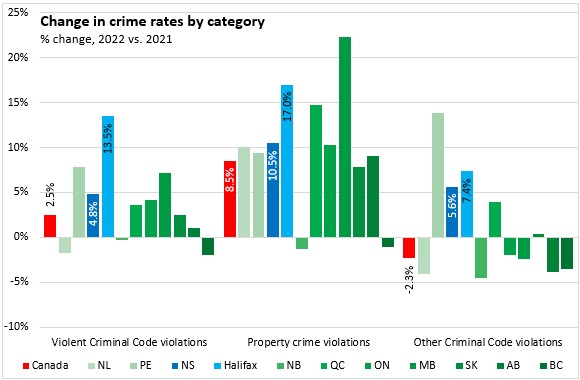
Violwent crime rates have been trending up for several years.
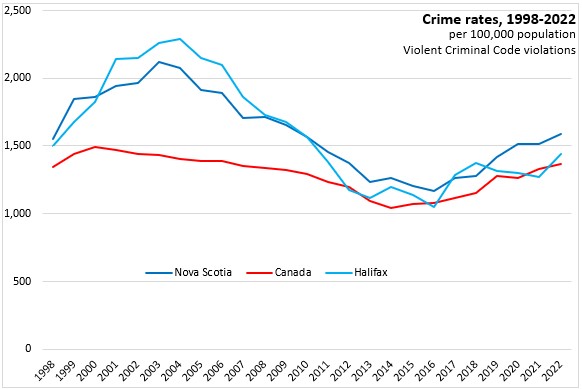
Property crime rates have only started to rise in recent years.
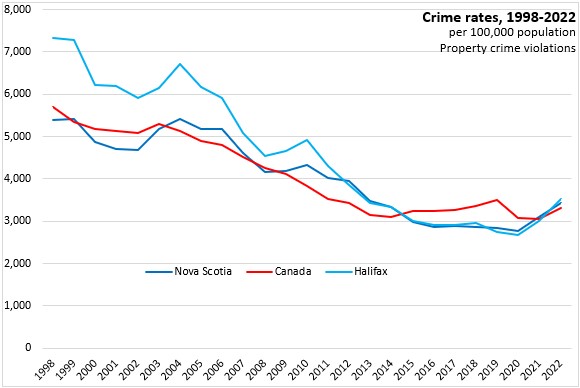
Rates of other criminal code violations increased prior to the pandemic. There were notable declines in other Criminal Code violations in Nova Scotia (particularly Halifax) in 2021, before a rebound in 2022.
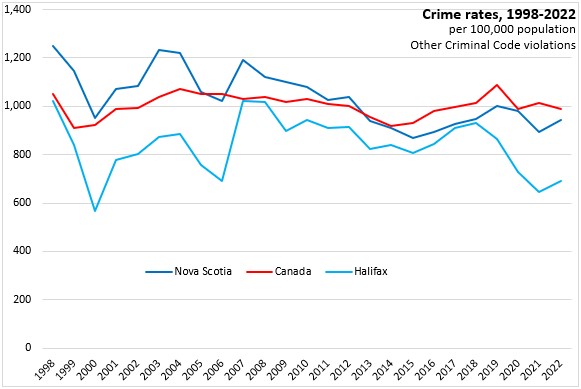
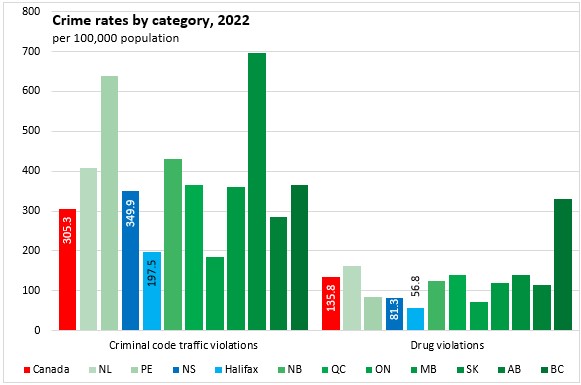
Nova Scotia reported 349.9 Criminal Code traffic violations per 100,000 residents in 2022, which was above the national average of 305.3. There were 197.5 Criminal Code traffic violations per 100,000 residents in Halifax.
Nova Scotia's drug violation rate was 81.3 per 100,000 residents while Halifax's was 56.8. The national drug violation rate was 135.8 per 100,000 residents.

Criminal code traffic violations fell by 12.2% in Nova Scotia in 2022 (-6.5% in Halifax). Criminal code traffic violations were down 2.6% nationally with declines in all provinces except New Brunswick. Saskatchewan had the largest decline in Criminal Code traffic violations.
Drug violations were down 17.9% in Nova Scotia (-5.7% in Halifax). There was a 16.8% drop in drug violations nationally with declines in all provinces except Prince Edward Island. Saskatchewan had the largest decline in drug violations.
After rising in 2019, criminal code traffic violations have been down in each of the last three years in Nova Scotia (as well as in Halifax and Canada overall).

Drug crime rates have been trending down, particularly after 2018.
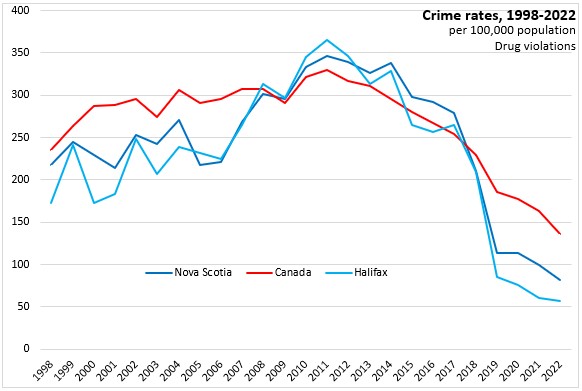
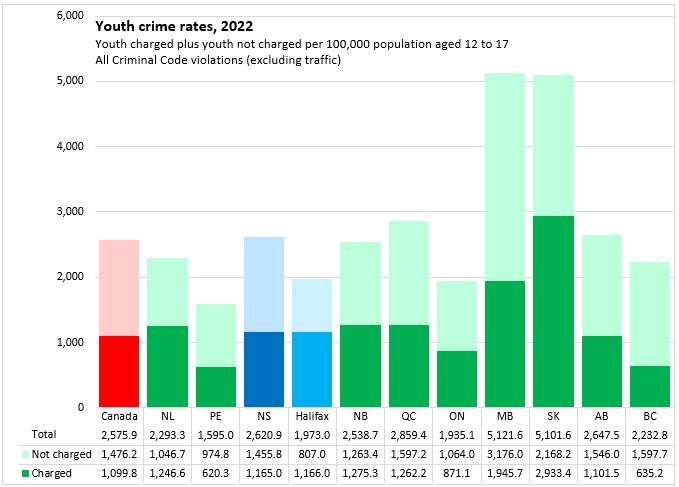
Nova Scotia's youth crime rate in 2022 was 2,620.9 violations per 100,000 residents aged 12-17, which was higher than the national youth crime rate (2,575.9). The youth crime rate was lower in Halifax (1,973.0). Youth crime rates were higher in Manitoba and Saskatchewan. Note the youth crime rates are divided into youth who are charged for a reported crime as well as youth who are not charged for a reported crime.
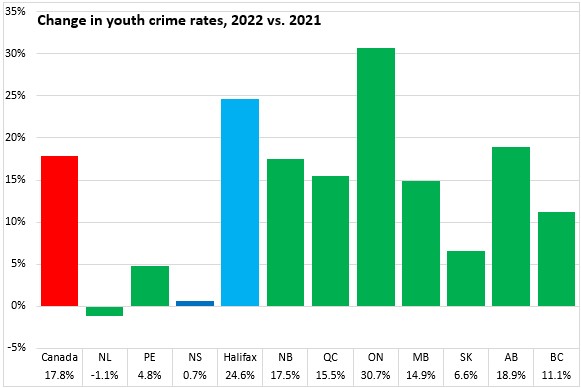
The youth crime rate increased 0.7% in Nova Scotia, but rose sharply in Halifax (+24.6%). The national youth crime rate was up 17.8%. Youth crime rates were up in all provinces except Newfoundland and Labrador. Ontario reported the fastest increase in youth crime rates.
Crime severity
The overall severity of crime, as measured by the Total Crime Severity Index (CSI) was 74.7 in Nova Scotia and 72.2 in Halifax. The national average crime severity was 78.1 with the highest rates in Manitoba and Saskatchewan and the lowest rates in Ontario, Québec and Prince Edward Island.

Across municipalities, Winnipeg and Kelowna reported the highest crime severity rates while Québec City and Barrie reported the lowest. Most cities in central and Atlantic Canada reported lower crime severity with the exception of Moncton.

The crime severity index increased 3.4% in Nova Scotia from 2021 to 2022 while it rose by 8.4% in Halifax. Nationally, crime severity was up 4.3% with increases in all provinces except New Brunswick. Manitoba reported the steepest rise in crime severity.

Among cities, Winnipeg, Gatineau and St. John's reported the fastest rises in crime severity. Windsor reported the largest decline.

Like crime rates overall, the crime severity index declined for several years before rising slowly in the most recent decade.
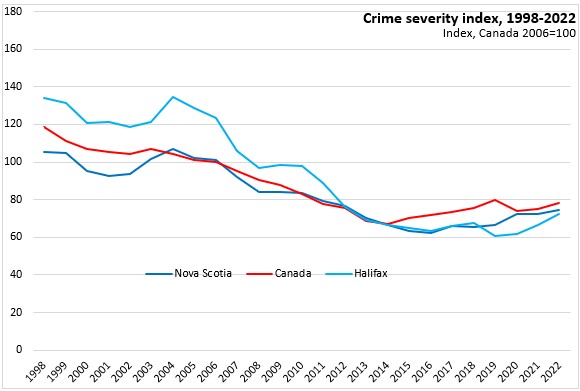
The severity of violent crimes has had a sharper increase in the last decade.

Non-violent crime severity has been more stable in recent years than violent crime severity.
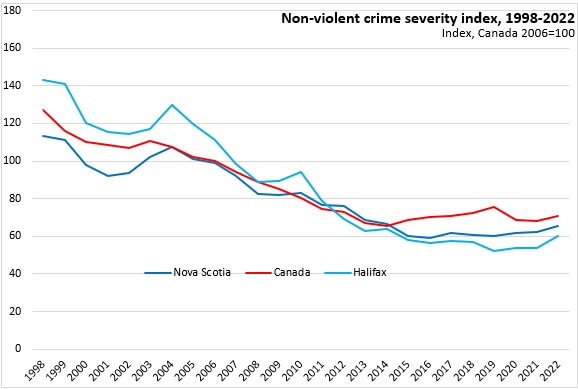
NOTE: on January 1, 2018, Statistics Canada, in collaboration with police, changed the definition of “founded” criminal incidents. With the new definition, there is the potential that police will classify more incidents as founded.
Definitions:
Incident (or Offence): A criminal incident involves one or more related offences that are committed during a single criminal event and have been reported to police.
Violent offences: Involve the use or threat of violence against a person, including homicide, attempted murder, assault, sexual assault and robbery.
Non-violent offences: Include property offences and other Criminal Code offences, as well as Criminal Code traffic offences, drug-related offences and violations of other federal statutes.
Sexual assault: Is classified by level in the Criminal Code into three separate categories—depending on the nature and severity of the incident—including level 1, assault of a sexual nature that violates the sexual integrity of the victim; level 2, sexual assault with a weapon or causing bodily harm involves sexual assault with a weapon, threats to use a weapon or causing bodily harm; and level 3, aggravated sexual assault involves sexual assault that wounds, maims, disfigures or endangers the life of the victim.
“Other” Criminal Code offences: Include crimes such as disturbing the peace and offences against the administration of justice (e.g., failure to comply with an order, failure to appear and breach of probation).
Source: Statistics Canada. Table 35-10-0026-01 Crime severity index and weighted clearance rates, Canada, provinces, territories and Census Metropolitan Areas, Table 35-10-0177-01 Incident-based crime statistics, by detailed violations, Canada, provinces, territories and Census Metropolitan Areas
<--- Return to Archive